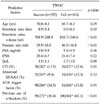Abstract
Purpose
Benign prostatic hyperplasia (BPH) is a common problem that's experienced by aging men, and it can lead to serious outcomes, including acute urinary retention (AUR). We studied the factors that influence the clinical outcomes after trial without catheter (TWOC) for AUR due to BPH.
Materials and Methods
The medical records of all 455 BPH patients who visited the emergency room for the first time with AUR from March 2001 through February 2005 were retrospectively reviewed. The patients were divided into two groups: the success group (group I) or failure group (group II) that underwent trial without catheter. The patient's characteristics were compared between the two groups using logistic regression analysis and the chi-square test.
Figures and Tables
Fig. 1
Success rate of trial without catheter after acute urinary retention according to the retention urine volume, the prostate size and the previous use of α-blockers (p<0.01).

References
1. Kurita Y, Masuda H, Terada H, Suzuki K, Fujita K. Transition zone index as a risk factor for acute urinary retention in benign prostatic hyperplasia. Urology. 1998. 51:595–600.
2. Lepor H. The pathophysiology of lower urinary tract symptoms in the ageing male population. Br J Urol. 1998. 81:Suppl 1. 29–33.
3. Mebust WK, Holtgrewe HL, Cockett AT, Peters PC. Transurethral prostatectomy: immediate and postoperative complications. A cooperative study of 13 participating institutions evaluating 3,885 patients. J Urol. 1989. 141:243–247.
4. Murray K, Massey A, Feneley RC. Acute urinary retention-a urodynamic assessment. Br J Urol. 1984. 56:468–473.
5. Pickard R, Emberton M, Neal DE. National Prostatectomy Audit Group. The management of men with acute urinary retention. Br J Urol. 1998. 81:712–720.
6. McNeill SA. The role of alpha-blockers in the management of acute urinary retention caused by benign prostatic obstruction. Eur Urol. 2004. 45:325–332.
7. McNeill SA, Hargreave TB. Members of the Alfaur Study Group. Alfuzosin once daily facilitates return to voiding in patients in acute urinary retention. J Urol. 2004. 171:2316–2320.
8. Annemans L, Cleemput I, Lamotte M, McNeill A, Hargreave T. The economic impact of using alfuzosin 10 mg once daily in the management of acute urinary retention in the UK: a 6-month analysis. BJU Int. 2005. 96:566–571.
9. Manikandan R, Srirangam SJ, O'Reilly PH, Collins GN. Management of acute urinary retention secondary to benign prostatic hyperplasia in the UK: a national survey. BJU Int. 2004. 93:84–88.
10. Taube M, Gajraj H. Trial without catheter following acute retention of urine. Br J Urol. 1989. 63:180–182.
11. Kumar V, Marr C, Bhuvangiri A, Irwin P. A prospective study of conservatively managed acute urinary retention: prostate size matters. BJU Int. 2000. 86:816–819.
12. Djavan B, Shariat S, Omar M, Roehrborn CG, Marberger M. Does prolonged catheter drainage improve the chance of recovering voluntary voiding after acute urinary retention (AUR). Eur Urol. 1998. 33:Suppl 1. 110. abstract 437.
13. Jacobsen SJ, Jacobson DJ, Girman CJ, Roberts RO, Rhodes T, Guess HA, et al. Natural history of prostatism: risk factors for acute urinary retention. J Urol. 1997. 158:481–487.
14. Hartung R. Do alpha-blocker prevent the occurrence of acute urinary retnetion? Eur Urol. 2001. 39:Suppl 6. 13–18.
15. McNeill AS, Rizvi S, Byrne DJ. Prostate size influences the outcome after presenting with acute urinary retention. BJU Int. 2004. 94:559–562.
16. Cockett AT, Khoury S, Aso Y. Proceedings of the 3rd International Consultation on benign prostatic hyperplasia. 1995. Channel Island: Scientific Communications International Ltd;1–651.
17. McConnell JD, Roehrborn CG, Bautista OM, Andriole GL Jr, Dixon CM, Kusek JW, et al. The long-term effect of doxazosin, finasteride, and combination therapy on the clinical progression of benign prostatic hyperplasia. N Engl J Med. 2003. 349:2387–2398.
18. Shim JH, Sohng IH, Jee KN, Kim HJ. Follow-up treatment of benign prostatic hyperplasia with acute urinary retention. Korean J Urol. 2006. 47:20–25.
19. Martorana G, Giberti C, Di Silverio F, von Heland M, Rigatti P, Colombo R, et al. Effects of short-term treatment with the alpha 1-blocker alfuzosin on urodynamic pressure/flow parameters in patients with benign prostatic hyperplasia. Eur Urol. 1997. 32:47–53.




 PDF
PDF ePub
ePub Citation
Citation Print
Print





 XML Download
XML Download